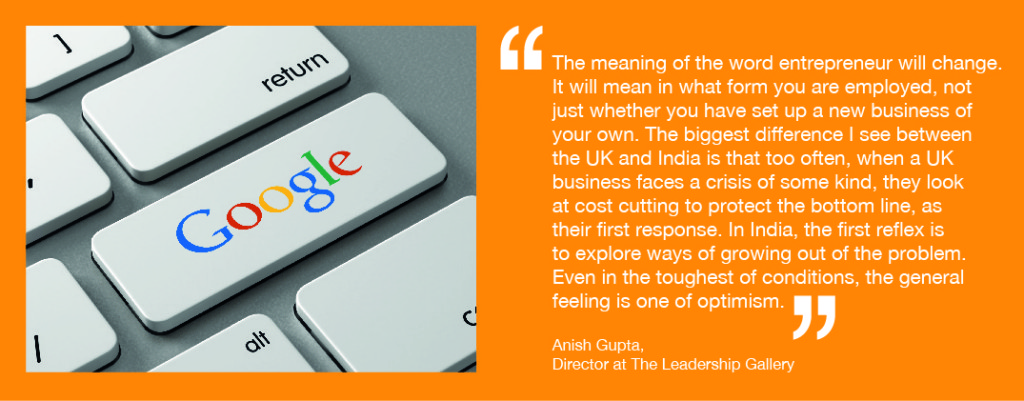Why Brands Need To Crowdsource Civic Imagination
THE EVENING DEBATE
Thomas Ermacora gave a 90min talk based sharing some of the ideas from his work and the development of his current newmedia book project (© The Next Man) to provide a framework for the evening’s discussions. His insightful and thought-provoking presentation inspired a lively debate and many questions from the guests at this month’s HoneyBuzz.The main ideas, topics and themes that Thomas introduced are briefly outlined in the output below.
Thomas opened his talk by giving his personal definition of being a futurist. There are those who watch trends and extrapolate to predict the future and others, like Thomas, that are interested in imagining what the future could look like and then working towards making it happen. He went on to explain what he means when he talks about accelerating change – ‘it’s not about speed; it’s about creating the velocity to carry people forward.’
So how do we define progress? He believes this isn’t about right or wrong, or an issue of morality. For many communities it’s when people agree they have reached something that is ‘preferable’. Thomas’ own background as a multicultural Danish-Italian who has lived in several world cities eventually steered him towards asking questions about how to create a sense of community and a sense of belonging – and sustainability is at the heart of this.

The Next Man is an expression that Thomas uses to identify the moment in time we are living in right now as we move towards what Ray Kurtzweil calls the Singularity – when the technosphere and biosphere will merge. He explained how Singularity University in the San Francisco Bay area is helping to educate leaders to apply exponential technologies to address humanity’s challenges. Some regard the organization as threatening because according to some it is also indirectly helping the wealthiest people achieve eternal life before others, but they are mainly focused on tackling major global problems that concern over one billion people at a time.
Between AI, biotech, nanotech, robotics and the Maker Movement, there will soon be an array of technology spilling over into our everyday lives.Thomas proposed that, over the next 30 years, we are going to have to figure out how to maintain our humanity for the next generation of mankind. Will we experience a profound sense of dismay that there are robots smarter than ourselves and that there are people with access to eternal life? Absolutely. To do this, Thomas suggests we need to build communities that are strong enough to have really difficult conversations.
The battle between Jane Jacobs and Robert Moses
Thomas spoke about the historic battle between activist Jane Jacobs and New York city planner Robert Moses, a clash of ideologies that we still see played out today in the planning of major cities. The former advocated urban planning that places the needs of people first, whilst the latter built highways through local communities – a legacy of planning decisions that led to New York being designed as a ‘car city’ and much of the major metropolitan areas in the world to follow that example. Thomas compared this with Copenhagen, where 50% of people now cycle to work. This isn’t because of convenience; it’s by design. By making a city slower, by literally changing the speed of movement,
Copenhagen is now the second most desirable city to live in the world according to many metrics.
Thomas has helped around 20 capital cities become more focused on promoting urban cycling. To design a city where the main mode of transport is the bicycle requires careful planning. Over the last 50 years, we haven’t been very successful at this. Go back to Victor Papenek, and his suggestions for what we should have been doing, then consider the implications of losing another 40 years experimenting. ‘The political establishment is poorly prepared for the kind of questions people will soon be asking. If leaders don’t have the answer, then is an open-source community the way forward?
Sustainable Architect of the Future
What happens if we engage a community to be able to dream together? Maybe we can achieve things we didn’t expect. Drawing on numerous references to modern architecture, Thomas discussed the vision and limitations of recent sustainable city projects. There’s Masdar City in Abu Dhabi, an ambitious eco-city designed by Foster and Partners. The terreform Fab Tree also shows promise, developed at by Mitchell Joachim while at MIT as a way to construct and grow our environments rather than put them together with components. Then there are design concepts for green ‘eco’ skyscrapers such as those designed by Ken Yeang. ‘The trouble is that these concept cities will struggle scaling fast and may become green ghettos and not become the desirable reality for the vast majority of the world’s population.’ Most of these attempts look like a lack of imagination, designed within an already outdated framework, using tools that we have available to us today.

In his book, Recoded City, Thomas explores alternatives to traditional top-down urban planning and discusses how cities can help themselves through creative regeneration projects that involve participatory design practices rather than waiting for help to be given. In an age where peoplecan find out what is happening in the world by checking their smartphones, he predicts that we will become tired of waiting and will decide or be obligated by circumstanceto self-organise.‘We have open-source software, open-source hardware, and today we are seeing the hatching of open-source urbanism where people can co-create, collaborate and help one another.
How do you ensure that a community takes ownership of public space, or what Thomas refers to as the ‘new urban commons’? Thomas’ approach to urban design is to involve everyone in creating places – even if they are not necessarily accredited professionals. This might include architects, social entrepreneurs, engineers etc but increasingly amateurs and members of the local community. Designers are often acknowledged or credited for coming up with the end solution with a magic wand, but the best ideas are most often co-created or at least co-generated. However, you still need thetalent and the skill to evolve the idea, and sometimes these skills cannot be appropriated without experience or training. In essence, we still need fundamental pioneers, but we also need facilitators and executors.
“Designers have been conditioned to be the neutral facilitator of a process. They now have the ability to facilitate, and that’s all through co-creation. Their job has become to listen quietly and absorb rather than to pioneer.”
Jim Dawton, Director at Impeller Ventures
In 2008 Thomas founded Clear Village, as a non-profit dedicated to finding paths to community resilience by tackling local issues through participatory projects that acted as catalysts for urban commons. The Clear Village process Thomas developed starts with listening to citizens and explores what is missing to bind the community with place. He calls this process ‘recoding’, assimilating it to recombining the DNA of Place in ways that involve locals rather leaving them as spectators of something they might reject.
This was a radical departure from Thomas’ previous work as a sustainable city masterplanning consultant, where everything was top-down decision making and commission based development. He rejected working in that fashion because he felt it wasn’t authentic sustainability as it was both leaving people out of the equation and often under-utilising passive sustainability features. He reminded us that active means using technology to create low carbon solutions whereas passive means using the natural qualities of a site to minimize carbon emissions such as bioclimatic architecture that designs buildings based on solar exposure.
“We have created a world where we don’t care about the places around us because they are owned by people we don’t know or care about. Who owns Starbucks? What’s their name? However much serfdom there was in feudal society, you knew who was the owner and if things became unbearable then you knew who to rebel against. Now people don’t know where to turn. However, even if the ownership doesn’t belong to the community, there are new management practices that could create the much needed sense of care.”
Thomas Ermacora
Thomas mentioned the example of Home for All, a project led by the Sendai reconstruction Task force in Japan headed by Toyo Ito, where even in a disaster struck zone, there was clear evidence of the paramount importance of the idea of bringing together people around a common need in a building dedicated to that function, be it child care or elderly care or anyting from culture to sports. The discussion soon shifted to gentrification, referring to areas of London such as Brixton and Hackney, where those who created value in the community (usually creative people, artists, the LGBT community, and multigenerational ethnic minorities) are displaced by higher rent prices.
Thomas noted that Richard Florida’s book ‘The Rise of the Creative Class’ had merit but that it inspired developers and planners to think in a way that comes to the dead end of mass gentrification of urban areas leaving fragile communities to move in difficult places or remote suburbia. He proposed that there are ways to avoid this. Gentrification is not all bad if it allows for a progressive leveling of the area in ways meritocratically inclusive to those who formed the local character and appeal of the place.

This is where his theory of Recoding places steps in suggesting that by creating a series of interventions that allow for people to take ownership and co-create places they can at times beat the pernicious effect of developer led urbanism. He pointed at how European cities are the most visited and appreciated because they have a ‘geology of human habitation and creativity’ that appeals to everyone. They are authentic and crafted through centuries not just planned from above, sold and occupied by franchises and high income renters.
“The idea with LimeWharf is to create a space that allows communities to think together and have difficult conversations. The places we have currently are not conducive to this. You can go to fractured places online or visit a church or a mosque, but are we really having the conversations that we need to have?”
Thomas Ermacora
The Rise of the Maker Community
Did you know that we had the technology to build an electric car in 1970s? We developed a hydrogen car even earlier. Thomas explained that the challenge is to create spaces where new technology can find outlets, where companies and communities can have open access to these skills. Maker Spaces are ideal learning environments for digital fabrication, 3D printing, CNC milling and other skills we will need to understand how to relocalise capacity and create a less wasteful global supply chain while keeping up with a growing global economy.
The current projections suggest that our current build environment stock will double by the year 2050 – that’s going to require a lot of concrete, steel and engineering. ‘Maker Spaces are also a great learning ground for robotics and AI and all the exponential technologies we will need to operate this global transformation more gracefully.’ So, could they be the key to empowering communities and preparing them for changes ahead? Some people around the table thought so, but others were sceptical about the economic significance of Maker Spaces.
LimeWharf, founded by Thomas, is a community centric cultural innovation centre in East London that is helping to encourage open source thinking and the Maker Movement through various initiatives. He recently got planning for his design with Carmody Groarke to extend the center into the first zero carbon BREAM excellent public building in that part of the city.
His work in the last five years has led to him forming alliances locally and shape what is now known as the Maker Mile, a ‘square mile’ of maker businesses connected and sharing the Machines Room (Thomas’s maker space) as an infrastructure to connect and work together towards the first open source circular economy district in Europe. Thomas reminded us that there are now over 600 Fab Labs all over the world that are dedicated to giving people access to technology and an understanding of where fabrication technology is going.
The economy is changing and soon machines will be able to do the work, but we need a system where humans can at least participate even when machines have more emotional intelligence than us.
The Impact of Mega Cities
The building of mega cities in China has had a massive impact on local communities. Huge swathes of the population have been moved, whether they wanted to or not. Whatever you think about China’s politics, they went from being irrelevant to being a global power in a short period of time through top-down urban planning. However, India, which is the largest democracy in the world, is taking the opposite approach and negotiating between corporate interests and community interests
“The thinking seems to sit in an articulation gap between political will coming down and community interests coming up. I’m trying to work out where the will is going to come from.”
Roger Jones, Digital Strategy Consultant at Actionable Insight
In the case of London City Airport, there was much debate around the table as to which community should be respected and to what degree. Although the financial benefits to the immediate community are few, there are four million people who pass through the airport every year. Should we also consider their interests, the interests of international students and tourists, or the global responsibility that London now has?
“My interest is in the voices that are not heard. If you go online and research the pollution problem caused by London City Airport then you only hear the voices of those who control the project. Even if you look on a more democratic level at what discussions people are having on social media, they are so fragmented and down to opinion that they are insignificant. There is no evidence for a consultation with the local community or that there is any kind of democracy in place.”Michele Turriani, Photographer at Michele Turriani
“The Maker economy is going to be very significant because the Internet of Things will connect every device around us and us included in the next decades. Beyond the corporate environment, maker solutions and open source designs will democratize this shift and billions of dollars will be raised through crowdfunding platforms.”
Thomas Ermacora
This started a controversial debate about what the future looks like for industry. Is it possible that the whole concept of work and relationship in the community will be changed? Thomas argued that this will be the case – that, out of necessity, people will have multiple start-ups in the next economy and that the days of a monogamous entrepreneurial journey will soon be over.
“I spoke to a start-up called Too Good To Go who are tackling the issue of food waste. If they are successful their company will have delivered on their initial insight. The founders are young guys and know they are not creating a company to run in the hierarchy that we are born into.”
Lulu Laidlaw-Smith, Commercial Director at Honey Creative
Big entrepreneurs may have traditionally come from some kind of wealth, but there are also many people around the world who have made their life more meaningful and risen from poverty through entrepreneurship. Richard Branson and James Dyson were referenced as success stories, but the reality is that there are many more people in developing countries who are reaching their potential and getting themselves out of a position of strife.
“Growth and entrepreneurialism are very different. I’ve met loads of inventors, loads of business people, loads of entrepreneurial people, but very few serial entrepreneurs. That is a very specific type of person.”
Jim Dawton, Director at Impeller Ventures
Employment for life, whether in the public or private sector, is already a thing of the past for graduates entering the job market today. The relentless online transparency means that companies are competing more and more on price, and that often means that they are looking for new ways to minimise their fixed costs. Often cited as a classic argument for why robots will take our jobs, this theory also suggests that we may have to prepare for a new economic model altogether, or at least change our definition of employment.
“In the future, the attitude to employment will change. The term entrepreneur will come to mean in what form are you employed, and there will be development in the legal description of employment. We will be defined and valued based on our personal expertise rather than our industry or specific job experience.”Lulu Laidlaw-Smith, Commercial Director at Honey Creative
“To equip ourselves through this transition with more grace than fear, we need to build communities that are mutually supportive for when they are not successful with that transformation. We also need to allow for people to understand that they need to equip themselves with the skills to survive.”Thomas Ermacora




